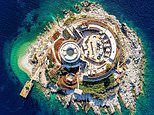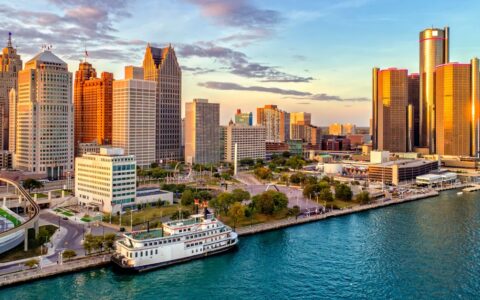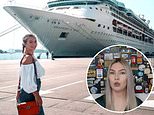
When Montenegro gained independence from Serbia in 2006, its then prime minister declared: ‘Montenegro will become one of the world’s most elite tourist destinations… Better than St Tropez.’
It may have been an ambitious statement, but almost two decades later the tiny country – squeezed between Albania, Bosnia-Herzegovina, Kosovo, Serbia and Croatia – is certainly on its way.
Tycoons now sunbathe off the coast on gigantic superyachts, the result of billions spent on gleaming marinas and the five-star hotels from some of the world’s most exclusive chains that have sprung up along the beaches.
Its latest opening, Mamula, is a beautifully restored 19th Century fortress, standing on its own tiny island in the heart of one of the Med’s prettiest stretches.
We fly to Dubrovnik in Croatia and then travel half an hour south along a dusty road lined by lofty cypress trees until we reach the border, where the landscape suddenly changes. Croatia’s rolling mountains surge upwards into giant peaks which drop dramatically down to the Adriatic and little terracotta-roofed towns hug the ocean’s edge.
Harriet Sime checks into Mamula (pictured), one of Montenegro’s latest hotel openings. The hotel, a converted 19th Century fortress, stands on its own tiny island
Laid-back luxury: Harriet says that Mamula (above) has ‘an almost monastic sense of solitude’
‘Welcome to the Balkans,’ our burly driver tells us with a wry smile as we join a queue of beeping cars.
There’s just one border guard checking passports for cars both entering and leaving Montenegro. He checks three or four passports before having a quick flick through his phone and crossing the road to start again on the other lane. We wait just 20 minutes but are told that in peak summer the queue can take six hours to pass through.
Montenegro, a country not much bigger than Yorkshire and with just 620,000 residents, isn’t part of the European Union – despite applying for membership in 2008. This is mainly due to a deepening political crisis which recently saw its prime minister ousted after 32 years in power.
Just a few minutes after crossing the border, we’re dropped at the entrance to the Bay of Kotor, a 15th Century, Unesco-listed, fjord-like inlet, where we board a speed boat and race across the glittering Adriatic while watching the cluster of villages stretch away behind.
Mamula island quickly comes into view. The soft, creamy, curving limestone walls of the fortress rise from the craggy rocks and frothing sea, while seagulls circle above.
On arrival we’re given a quick tour of the circular island – it’s just 650ft (200 metres) in diameter – before being taken to our room. It’s huge, with exposed stone walls and an arched roof, and is decked out in neutral wools and linens.
Despite dropping its drawbridge for the first time in April, the hotel is already busy with guests from around the world staying in one of its 22 suites or ten rooms.
There’s an almost monastic sense of solitude here. A common phrase you hear in Montenegro is ‘polako’, which means to take it slowly and don’t get stressed. It reflects the languid, laid-back atmosphere. Most of our days are spent at the pool, which lies suspended at the centre of the fort, or the tiny beach, where waves slap gently against the white rocks and catamarans sail past.
The circular island of Mamula is just 650ft (200 metres) in diameter, Harriet reveals
Most of Harriet’s days are spent at Mamula’s pool (above), which lies suspended at the centre of the fort complex
Long legacy: Above is General Lazar Mamula, who built the Mamula fortress between 1851 and 1856
The island gets its name from General Lazar Mamula, who built the fortress between 1851 and 1856 as part of Austro-Hungarian fortifications forming a defensive line at the entrance of the Bay of Kotor.
Its past is controversial. The island was used as an Italian prison camp by Mussolini during the Second World War before being abandoned and falling into disrepair. There was opposition from some locals when plans were submitted by Egyptian billionaire Samih Sawiris in 2015 to transform the derelict fortress into a five-star hotel.
Despite the resistance, Sawiris was given a 49-year lease before beginning a minimally invasive reconstruction project alongside heritage authorities, which took seven years.
Every brick moved was numbered so it could be restored and replaced in exactly the same spot, and each new structure can be removed when the lease comes to an end so the island can be left exactly how it was found. I wasn’t sure how I would feel, had one of my family members met their end here – tourists sipping on champagne in the same building where people suffered.
But the island doesn’t shy away from its history and we’re encouraged to visit the museum and memorial gallery on site. Each September, a Memorial Day is held to mark the date on which the island was liberated from the Italians, and the families of those who lived here are invited to pay tribute.
Mamula is exactly the type of exclusive development the government had hoped would attract the world’s biggest spenders.
‘Mamula is exactly the type of exclusive development the government had hoped would attract the world’s biggest spenders,’ writes Harriet
Above is Mamula island before the derelict fortress was turned into a five-star hotel
Harriet takes Mamula’s free shuttle boat across the bay to the town of Herceg Novi (pictured)
Above is the gate to the Old Town of Herceg Novi where Harriet enjoys a glass of local wine ‘under the shade of a towering church’
Another is One & Only Portonovi, across the bay. One afternoon, a vintage speedboat transports us to Tapasake, One & Only’s Japanese restaurant, which has a pool overlooking the sea.
Tennis star Novak Djokovic comes here for a few weeks every year, presumably crossing the border from his hometown in Serbia. While drinking glasses of creamy chablis, we devour plates of tuna sashimi, bite-sized avocado tacos and chicken tempura as the sun settles over the sparkling Adriatic.
Montenegro seems to have kept hold of its quiet charm, despite all this new money. One day, we take Mamula’s free shuttle boat across the bay to the town of Herceg Novi, passing houses painted the colour of the lemons growing in their gardens. We’re dropped at the Old Town’s harbour and watch cats sunbathing on the tarmac and elderly fishermen hammering beneath their rusting boats.
A series of steep steps snake up through the maze of churches, tiny bars and Venetian-style stone villas with bottle-green shutters, leading us to a square where we order two glasses of local wine under the shade of a towering church. The price? Just £2.40 each.
Montenegrins are physically huge (they recently overtook the Dutch as the world’s tallest nation) and now hope to become giants of tourism. Let’s just hope that ‘polako’ lasts.
TRAVEL FACTS
Doubles at Mamula cost from £430 per night (mamulaisland.com). EasyJet offers flights from Gatwick to Dubrovnik, returns from £62 (easyjet.com).
Source link
CHECK OUT: Top Travel Destinations
READ MORE: Travel News



